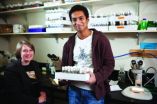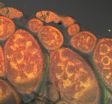(Press-News.org) Despite its appearance, which looks much like countless other galaxies, Messier 106 hides a number of secrets. Thanks to this image, which combines data from Hubble with observations by amateur astronomers Robert Gendler and Jay GaBany, they are revealed as never before.
At its heart, as in most spiral galaxies, is a supermassive black hole, but this one is particularly active. Unlike the black hole at the centre of the Milky Way, which pulls in wisps of gas only occasionally, Messier 106's black hole is actively gobbling up material. As the gas spirals towards the black hole, it heats up and emits powerful radiation. Part of the emission from the centre of Messier 106 is produced by a process that is somewhat similar to that in a laser - although here the process produces bright microwave radiation [1].
As well as this microwave emission from Messier 106's heart, the galaxy has another startling feature - instead of two spiral arms, it appears to have four. Although the second pair of arms can be seen in visible light images as ghostly wisps of gas, as in this image, they are even more prominent in observations made outside of the visible spectrum, such as those using X-ray or radio waves.
Unlike the normal arms, these two extra arms are made up of hot gas rather than stars, and their origin remained unexplained until recently. Astronomers think that these, like the microwave emission from the galactic centre, are caused by the black hole at Messier 106's heart, and so are a totally different phenomenon from the galaxy's normal, star-filled arms.
The extra arms appear to be an indirect result of jets of material produced by the violent churning of matter around the black hole. As these jets travel through the galactic matter they disrupt and heat up the surrounding gas, which in turn excites the denser gas in the galactic plane and causes it to glow brightly. This denser gas closer to the centre of the galaxy is tightly-bound, and so the arms appear to be straight. However, the looser disc gas further out is blown above or below the disc in the opposite direction from the jet, so that the gas curves out of the disc — producing the arching red arms seen here.
Despite carrying his name, Messier 106 was neither discovered nor catalogued by the renowned 18th century astronomer Charles Messier. Discovered by his assistant, Pierre Méchain, the galaxy was never added to the catalogue in his lifetime. Along with six other objects discovered but not logged by the pair, Messier 106 was posthumously added to the Messier catalogue in the 20th century.
Amateur astronomer Robert Gendler retrieved archival Hubble images of M 106 to assemble a mosaic of the centre of the galaxy. He then used his own and fellow astrophotographer Jay GaBany's observations of M 106 to combine with the Hubble data in areas where there was less coverage, and finally, to fill in the holes and gaps where no Hubble data existed.
The centre of the galaxy is composed almost entirely of Hubble data taken by the Advanced Camera for Surveys, Wide Field Camera 3, and Wide Field and Planetary Camera 2 detectors. The outer spiral arms are predominantly HST data colourised with ground-based data taken by Gendler's and GaBany's 12.5-inch and 20-inch telescopes, located at very dark remote sites in New Mexico, USA.
Gendler was a prizewinner in the recent Hubble's Hidden Treasures image processing competition. Another prizewinner, André van der Hoeven, entered a different version of Messier 106, combining Hubble and NOAO data.
INFORMATION:
Notes
The Hubble Space Telescope is a project of international cooperation between ESA and NASA.
[1] Lasers work when light stimulates emission of more light from a cloud of excited gas, with the original light in effect being amplified (the word laser is an acronym for light amplification by the stimulated emission of radiation). The centre of M106 harbours a similar phenomenon called a maser (short for microwave amplification by the stimulated emission of radiation), in which microwave radiation, which is at longer wavelengths than visible light, is emitted. Note that unlike man-made lasers, which are designed to produce a narrow beam, astronomical masers shine in all directions.
Credit: NASA, ESA, the Hubble Heritage Team (STScI/AURA), and R. Gendler (for the Hubble Heritage Team). Acknowledgment: J. GaBany, A van der Hoeven
Links
Images of Hubble: http://www.spacetelescope.org/images/archive/category/spacecraft/
Robert Gendler: http://www.robgendlerastropics.com/
Contacts
Oli Usher
Hubble/ESA
Garching bei München, Germany
A spiral galaxy with a secret
2013-02-05
ELSE PRESS RELEASES FROM THIS DATE:
Kaiser Permanente's anti-obesity interventions in schools show signs of success
2013-02-05
OAKLAND, Calif., February 5, 2013 – Community-based efforts to change the environment are proving to be an effective way of encouraging more physical activity and nutrition among school-age children, according to findings announced today from Kaiser Permanente. Researchers examined a series of Kaiser Permanente community-based obesity prevention interventions in adults and children and found that the more effective obesity prevention interventions were those that were "high dose" – reaching large populations with greater strength – and those that focused specifically on ...
21 minutes to marital satisfaction
2013-02-05
EVANSTON, Ill. --- Marital satisfaction -- so critical to health and happiness – generally declines over time. A brief writing intervention that helps spouses adopt a more objective outlook on marital conflict could be the answer.
New Northwestern University research shows that this writing intervention, implemented through just three, seven-minute writing exercises administered online, prevents couples from losing that loving feeling.
"I don't want it to sound like magic, but you can get pretty impressive results with minimal intervention," said Eli Finkel, lead author ...
Achilles heel: Popular drug-carrying nanoparticles get trapped in bloodstream
2013-02-05
ANN ARBOR—Many medically minded researchers are in hot pursuit of designs that will allow drug-carrying nanoparticles to navigate tissues and the interiors of cells, but University of Michigan engineers have discovered that these particles have another hurdle to overcome: escaping the bloodstream.
Drug delivery systems promise precision targeting of diseased tissue, meaning that medicines could be more effective at lower doses and with fewer side effects. Such an approach could treat plaques in arteries, which can lead to heart attacks or strokes.
Drug carriers would ...
Biologists map rare case of fitness-reducing interaction in nuclear, mitochondrial DNA
2013-02-05
BLOOMINGTON, Ind. -- A team of biologists from Indiana University and Brown University believes it has discovered the mechanism by which interacting mutations in mitochondrial and nuclear DNA produce an incompatible genotype that reduces reproductive fitness and delays development in fruit flies.
The new research, led by IU biologists Kristi Montooth and Colin Meiklejohn and including former IU undergraduate researcher Mo Siddiq, describes the cause and consequences of an interaction between the two genomes that co-exist within eukaryotic cells. Animal mitochondrial ...
EARTH: Moon could have formed from Earth after all
2013-02-05
Alexandria, VA –Scientists are revisiting the age-old question of how Earth's moon formed with the development of two new models that work out the complicated physics of planetary collisions. The idea of a moon-forming collision is not new: The Giant Impact Theory put forth in the 1970s suggested that the moon resulted from a collision with a protoplanet approximately half the size of ancient Earth. But the physics underlying such a collision implied that the moon should be made up of debris mostly from the protoplanet. Since then we've discovered the moon is instead very ...
Mitochondrial mutations: When the cell's 2 genomes collide
2013-02-05
PROVIDENCE, R.I. [Brown University] — Diseases from a mutation in one genome are complicated enough, but some illnesses arise from errant interactions between two genomes: the DNA in the nucleus and in the mitochondria. Scientists want to know more about how such genomic disconnects cause disease. In a step in that direction, scientists at Brown University and Indiana University have traced one such incompatibility in fruit flies down to the level of individual nucleotide mutations and describe how the genetic double whammy makes the flies sick.
"This has relevance to ...
Old age offers no protection from obesity's death grip
2013-02-05
Obesity kills, giving rise to a host of fatal diseases. This much is well known. But when it comes to seniors, a slew of prominent research has reported an "obesity paradox" that says, at age 65 and older, having an elevated BMI won't shorten your lifespan, and may even extend it. A new study takes another look at the numbers, finding the earlier research flawed. The paradox was a mirage: As obese Americans grow older, in fact, their risk of death climbs.
Ryan Masters, PhD, and Bruce Link, PhD, at Columbia University's Mailman School of Public Health, in collaboration ...
Giving transplanted cells a nanotech checkup
2013-02-05
Researchers at Johns Hopkins have devised a way to detect whether cells previously transplanted into a living animal are alive or dead, an innovation they say is likely to speed the development of cell replacement therapies for conditions such as liver failure and type 1 diabetes. As reported in the March issue of Nature Materials, the study used nanoscale pH sensors and magnetic resonance imaging (MRI) machines to tell if liver cells injected into mice survived over time.
"This technology has the potential to turn the human body into less of a black box and tell us if ...
Next-gen e-readers: Improved 'peacock' technology could lock in color for high-res displays
2013-02-05
ANN ARBOR—Iridescence, or sheen that shifts color depending on your viewing angle, is pretty in peacock feathers. But it's been a nuisance for engineers trying to mimic the birds' unique color mechanism to make high-resolution, reflective, color display screens.
Now, researchers at the University of Michigan have found a way to lock in so-called structural color, which is made with texture rather than chemicals. A paper on the work is published online in the current edition of the Nature journal Scientific Reports.
In a peacock's mother-of-pearl tail, precisely arranged ...
Samoan obesity epidemic starts at birth
2013-02-05
PROVIDENCE, R.I. [Brown University] — As some Pacific island cultures have "westernized" over the last several decades, among the changes has been a dramatic increase in obesity. Researchers don't understand all the reasons why, but even a decade ago in American Samoa 59 percent of men and 71 percent of women were obese. A new Brown University study finds that the Samoan epidemic of obesity may start with rapid weight gain in early infancy.
The implications of the study published online in the journal Pediatric Obesity may not be confined to Polynesian populations, said ...



